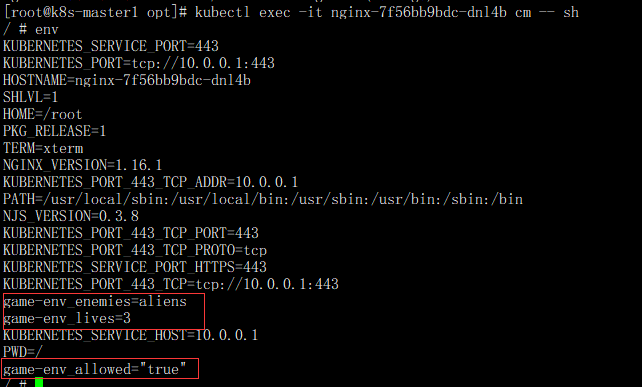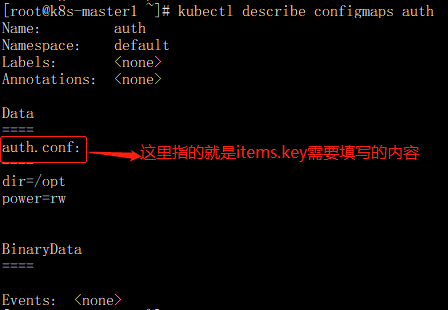Kubernetes基础配置管理
一、ConfigMap创建
1-1、基于目录创建ConfigMap
- 首先创建一个configmap/conf存储目录,分别建立.conf文件
mkdir /configmap/conf #创建。conf文件和添加内容 vim passwd.conf username=user1 pwd=12345 #创建第二个conf文件和内容 dir=/home power=rw
- 基于目录创建configMap命令。kubectl create configmap <映射名称> <数据源>
#命令使用介绍 kubectl create configmap <映射名称> <数据源> #示例 [root@k8s-master1 conf]# kubectl create configmap cm --from-file=/configmap/conf/ configmap/cm created
注:
cm :指的是映射名称
--from-file= 指向数据源(/configmap/conf目录)
- 查看基于configMap目录创建状态
#查看方式1是否创建了cm映射对象 [root@k8s-master1 conf]# kubectl get cm NAME DATA AGE cm 2 16s kube-root-ca.crt 1 6d19h #基于describe命令查看创建的内容 [root@k8s-master1 conf]# kubectl describe configmaps cm Name: cm Namespace: default Labels: <none> Annotations: <none> Data ==== auth.conf: ---- dir=/home power=rw passwd.conf: ---- username=user1 pwd=12345 BinaryData ==== Events: <none>
注:
目录/configmap/conf下的auth.conf和passwd.conf两个文件里面的内容出现在了Data下面
- 利用yaml文件格式查看创建内容
[root@k8s-master1 conf]# kubectl get configmaps cm -oyaml
apiVersion: v1
data:
auth.conf: |
dir=/home
power=rw
passwd.conf: |
username=user1
pwd=12345
kind: ConfigMap
metadata:
creationTimestamp: "2022-09-27T01:57:56Z"
name: cm
namespace: default
resourceVersion: "202341"
uid: 583e2a95-d81b-49c1-8eee-659a2f601507
1-2、基于文件创建configMap
说明:你可以使用 kubectl create configmap 基于单个文件或多个文件创建 ConfigMap。
- 基于文件创建configMap命令
[root@k8s-master1 conf]# kubectl create configmap passwd --from-file=/configmap/conf/passwd.conf configmap/passwd created
- 查看创建状态
[root@k8s-master1 conf]# kubectl get cm passwd NAME DATA AGE passwd 1 5m [root@k8s-master1 conf]# kubectl describe configmap passwd Name: passwd Namespace: default Labels: <none> Annotations: <none> Data ==== passwd.conf: ---- username=user1 pwd=12345 BinaryData ====
--from-file参数,从多个数据源创建 ConfigMap。
kubectl create configmap auth-pwd --from-file=/configmap/conf/auth.conf --from-file=/configmap/conf/passwd.conf
注:根据上面查看状态命令使用
1-3、使用 --from-env-file 选项从环境文件创建 ConfigMap,例如:
Env 文件包含环境变量列表。其中适用以下语法规则:
-
-
- Env 文件中的每一行必须为 VAR=VAL 格式。
- 以#开头的行(即注释)将被忽略。
- 空行将被忽略。
- 引号不会被特殊处理(即它们将成为 ConfigMap 值的一部分)。
-
- 示例文件
vim game-env.conf enemies=aliens lives=3 allowed="true"
- --from-env-file创建示例
[root@k8s-master1 conf]# kubectl create configmap game-env --from-env-file=/configmap/conf/game-env.conf configmap/game-env created
- 创建状态
[root@k8s-master1 conf]# kubectl describe configmaps game-env Name: game-env Namespace: default Labels: <none> Annotations: <none> Data ==== enemies: ---- aliens lives: ---- 3 allowed: ---- "true" BinaryData ==== Events: <none>
注:从 Kubernetes 1.23 版本开始,kubectl 支持多次指定 --from-env-file,多个文件创建跟--from-file一样
二、ConfigMap使用方法
2-1、生成一个deployment nginx yaml文件,把生成的yaml文件追加到nginx-configmap.yaml里面
#生成yaml命令
kubectl create deploy nginx --image=nginx:1.16.1-alpine --dry-run=client -oyaml > nginx-configmap.yaml
#对生成的yaml文件删除不使用参数,删除参数后的yaml文件如下
apiVersion: apps/v1
kind: Deployment
metadata:
labels:
app: nginx
name: nginx
spec:
replicas: 1
selector:
matchLabels:
app: nginx
template:
metadata:
creationTimestamp: null
labels:
app: nginx
spec:
containers:
- image: nginx:1.16.1-alpine
name: nginx
2-2、利用valueFrom定义容器环境变量。单个ConfigMap中的数据定义容器环境变量,修改nginx-configmap.yaml文件
apiVersion: apps/v1
kind: Deployment
metadata:
labels:
app: nginx
name: nginx
spec:
replicas: 1
selector:
matchLabels:
app: nginx
template:
metadata:
creationTimestamp: null
labels:
app: nginx
spec:
containers:
- image: nginx:1.16.1-alpine
name: nginx
env:
- name: LIEVS
valueFrom:
configMapKeyRef:
name: game-env
key: lives
注;
2-2-1、添加内容为:
env:
- name: LIEVS #生成容器里面的环境变量名称
valueFrom:
configMapKeyRef:
name: game-env #生成configMap的映射名称,利用kubectl get configmaps查看
key: lives #生成configMap环境变量key
2-2-2、进入nginx容器终端查看利用configMap设置的LIEVS环境变量,红色方框是实在的变量

2-2-3、key: lives 指的就是如果红色方框查询处的key

2-2-4、可以添加多个环境变量,可以直接拷贝 如下:
- name: LIEVS #改成新的容器里面的环境变量名称
valueFrom:
configMapKeyRef:
name: game-env #生成configMap的映射名称,利用kubectl get configmaps查看
key: lives #生成configMap环境变量key
2-3、利用envFrom实现批量环境变量设置
apiVersion: apps/v1
kind: Deployment
metadata:
labels:
app: nginx
name: nginx
spec:
replicas: 1
selector:
matchLabels:
app: nginx
template:
metadata:
creationTimestamp: null
labels:
app: nginx
spec:
containers:
- image: nginx:1.16.1-alpine
name: nginx
envFrom:
- configMapRef:
name: game-env
prefix: game_env
注:
#利用envFrom这里的配置是实现批量环境变量设置
envFrom:
- configMapRef:
name: game-env #这里是创建的ConfigMap容器名称
prefix: game_env_ #这里设置的是实区服是通过CofingMap还是自定义实现添加前缀字段
查看实现批量状态和设置区服前缀字段,如图红色框前缀显示

2-4、以文件的形式挂载ConfigMap
apiVersion: apps/v1
kind: Deployment
metadata:
labels:
app: web
name: web
spec:
replicas: 1
selector:
matchLabels:
app: web
template:
metadata:
creationTimestamp: null
labels:
app: web
spec:
containers:
- image: nginx:1.16.1-alpine
name: nginx
volumeMounts:
- name: auth-volume
mountPath: /etc/config
volumes:
- name: auth-volume
configMap:
#提供包含要添加到容器中的文件的 ConfigMap 的名称
name: auth
注:volumes 部分下添加 ConfigMap 名称。 这会将 ConfigMap 数据添加到 volumeMounts.mountPath 所指定的目录 (在本例中为 /etc/config)
2-4-1、利用volumes挂载文件相关配置注解
volumeMounts:
- name: auth-volume #在这的auth-volume需要跟volues.-name下面的名称一致
mountPath: /etc/config #指定挂载目录路径
volumes:
- name: auth-volume #volumes.-name名称
configMap:
name: auth #提供包含要添加到容器中ConfigMap 的名称,可以通过kubectl get configmaps
2-4-2、挂载文件验证
[root@k8s-master1 opt]# kubectl exec -it web-64d4ff5dd9-q9tjw -- sh / # ls -l /etc/config/ total 0 lrwxrwxrwx 1 root root 16 Sep 28 07:09 auth.conf -> ..data/auth.conf / # cat /etc/config/auth.conf dir=/home power=rw
2-4-3、通过实现在线编辑,挂载文件内容进行自动修改
#把dir=/home修改为dir=/opt kubectl get configmaps
查看修改后的内容状态
[root@k8s-master1 opt]# kubectl exec -it web-64d4ff5dd9-q9tjw -- sh / # cat /etc/config/auth.conf dir=/opt power=rw
注:修改后有可能会有相应的时间等待刷新。如果在程序中使用这个功能需要关注程序是否有热加载功能,如果程序没有加载功能修改后的配置程序不读取生效。
2-5、自定义挂载文件权限和名称
apiVersion: apps/v1
kind: Deployment
metadata:
labels:
app: web
name: web
spec:
replicas: 1
selector:
matchLabels:
app: web
template:
metadata:
creationTimestamp: null
labels:
app: web
spec:
containers:
- image: nginx:1.16.1-alpine
name: nginx
volumeMounts:
- name: auth-volume
mountPath: /etc/config
volumes:
- name: auth-volume
configMap:
#提供包含要添加到容器中的文件的 ConfigMap 的名称
name: auth
items:
- key: auth.conf
path: auth.conf-back
注:
items: - key: auth.conf #kubectl describe configmaps auth 查到data下面的名称,如下图红色方框内容指的就是这里的key path: auth.conf-back #自定义挂载文件名称

2-5-1、刷新yaml文件
kubectl replace -f web-volumes.yaml
2-5-2、查看自定义挂载文件名称

2-5-3、修改自定义挂载文件权限
apiVersion: apps/v1
kind: Deployment
metadata:
labels:
app: web
name: web
spec:
replicas: 1
selector:
matchLabels:
app: web
template:
metadata:
creationTimestamp: null
labels:
app: web
spec:
containers:
- image: nginx:1.16.1-alpine
name: nginx
volumeMounts:
- name: auth-volume
mountPath: /etc/config
volumes:
- name: auth-volume
configMap:
#提供包含要添加到容器中的文件的 ConfigMap 的名称
name: auth
items:
- key: auth.conf
path: auth.conf-back
defaultMode: 0666
查看挂载文件权限修改后如果:

注:
1、defaultMode: 0666 设置挂载文件权限
2、可以对照源文件权限2-5-2图。查权限需要进入 ..data目录里面可以安装图上面的操作步骤,因为auth.conf-back是通过软连接建立
三、Secret创建
3-1、由用户名和密码组成的数据库连接字符串。 你可以在本地计算机上,将用户名存储在文件
/secret/conf/username.txt 中,将密码存储在文件 /secret/conf/password.txt 中
[root@k8s-master1 ~]# mkdir -p /secret/conf [root@k8s-master1 ~]# cd /secret/conf/ [root@k8s-master1 conf]# echo -n 'admin' > username.txt [root@k8s-master1 conf]# echo -n '1f2d1e2e67df' > password.txt [root@k8s-master1 conf]# ls -l total 8 -rw-r--r-- 1 root root 12 Sep 28 21:16 password.txt -rw-r--r-- 1 root root 5 Sep 28 21:16 username.txt
3-2、kubectl create secret 命令创建secret
#创建 [root@k8s-master1 conf]# kubectl create secret generic db-user-pass \ > --from-file=/secret/conf/username.txt \ > --from-file=/secret/conf/password.txt secret/db-user-pass created #查看创建状态 [root@k8s-master1 conf]# kubectl get secrets db-user-pass -oyaml apiVersion: v1 data: password.txt: MWYyZDFlMmU2N2Rm #password.txt保存的密码进行了base64加密 username.txt: YWRtaW4= #username.txt保存的用户名进行了base64加密 kind: Secret metadata: creationTimestamp: "2022-09-28T13:18:38Z" name: db-user-pass namespace: default resourceVersion: "277748" uid: 8298357e-1b36-41ce-9b68-72ed958960e5 type: Opaque
3-3、通过yaml创建secret
#yaml文件 apiVersion: v1 kind: Secret metadata: name: mysecret type: Opaque data: username: YWRtaW4= password: MWYyZDFlMmU2N2Rm #创建secret kubectl create -f secret.yaml
3-4、删除创建secret操作命令
kubectl delete secret mysecret
3-5、使用Secret拉取私有镜像仓库命令
kubectl create secret docker-registry myregistrykey \ --docker-server=DOCKER_REGISTRY_SERVER \ --docker-username=DOCKER_USER \ --docker-password=DOCKER_PASSWORD \ --docker-email=DOCKER_EMAIL
注:
➢ docker-registry:指定Secret的类型
➢ myregistrykey: Secret名称
➢ DOCKER_REGISTRY_SERVER:镜像仓库地址
➢ DOCKER_USER:镜像仓库用户名,需要有拉取镜像的权限
➢ DOCKER_PASSWORD:镜像仓库密码
➢ DOCKER_EMAIL:邮箱信息,可以为空
3-6、配置yaml文件用户名和密码下载私有镜像仓库镜像
apiVersion: apps/v1
kind: Deployment
metadata:
labels:
app: web
name: web
spec:
replicas: 1
selector:
matchLabels:
app: web
template:
metadata:
creationTimestamp: null
labels:
app: web
spec:
imagePullSecrets:
- name: myregistry #创建的kubectl create secret docker-registry 容器名称
containers:
- image: 私有镜像连接地址
name: nginx
注:
imagePullSecrets 设置获取私有镜像用户和密码
- name: myregistry #指的是创建secret docker-registry 容器是的名称
四、解决挂载volumeMounts挂载覆盖问题,主要修改mountPath和添加subPath参数。如以下示例
apiVersion: apps/v1
kind: Deployment
metadata:
labels:
app: web
name: web
spec:
replicas: 1
selector:
matchLabels:
app: web
template:
metadata:
creationTimestamp: null
labels:
app: web
spec:
imagePullSecrets:
- name: myregistry
containers:
- image: nginx:1.16.1-alpine
name: nginx
volumeMounts:
- name: nginx-conf
mountPath: /etc/nginx/nginx.conf #以文件的形式进行挂载,不要覆盖整个目录
subPath: nginx.conf #挂载配置文件名称
volumes:
- name: nginx-conf
configMap:
#提供包含要添加到容器中的文件的 ConfigMap 的名称
name: nginx-conf
注:
1、主要修改mountPath: 把这里的路径直接指向到配置文件(如mountPath: /etc/nginx/nginx.conf )。已配置文件的形式镜像挂载,告诉容器不要覆盖整个目录。
2、mountPath下方添加subPath参数指向配置文件名称
五、关于ConfigMap和secret 热更新问题
说明:首先修改configMap或Secret的创建时 --from-file指向的配置文件。例如ConfigMap passwd.conf 配置文件内容修改后使用以下命令,进行对ConfigMap更新
kubectl create configmap auth --from-file=/configmap/conf/auth.conf --dry-run=client -oyaml | kubectl replace -f -
5-1、查看passwd.conf配置文件原来内容如下:
[root@k8s-master1 conf]# cat /configmap/conf/passwd.conf username=user1 pwd=12345 [root@k8s-master1 conf]# kubectl describe configmaps passwd Name: passwd Namespace: default Labels: <none> Annotations: <none> Data ==== passwd.conf: ---- username=user1 pwd=12345 BinaryData ==== Events: <none>
把username=user1 修改为username=user2
5-2、更新ConfigMap和查看更新后内容
#修改配置文件后更新操作命令 [root@k8s-master1 opt]# kubectl create configmap passwd --from-file=/configmap/conf/passwd.conf --dry-run=client -oyaml | kubectl replace -f - configmap/passwd replaced #更新后查看更新内容 [root@k8s-master1 opt]# kubectl describe configmaps passwd Name: passwd Namespace: default Labels: <none> Annotations: <none> Data ==== passwd.conf: ---- username=user2 #这里已经把原来的user1更新为user2 pwd=12345 BinaryData ==== Events: <none>
注:Secret热更操作跟上面的示例一样




 浙公网安备 33010602011771号
浙公网安备 33010602011771号